Indian Music – Hindustani and Carnatic Music
Some prominent Personalities & their prominent work – associated with the development of Indian music
| Earliest Indian music | Sama Veda | Slokas were put to music |
| Bharata Muni | Natyashashtra | Earliest text dealing exclusively with performing arts |
| Matanga | Brihaddesi | Ragas were 1st named & discussed |
| Jayadeva | Gita Govinda | Depicts love of Radha and Krishna (Orissa) |
| Ibrahim Adil Shah II | Kitabe Navras | Songs in praise of Hindu deities & Muslim saints |
| Pundarika Vittal | Rangmala | |
| Abhinavagupta | Abhinavabharati | |
| Somadeva | Katha-sarit-sagar | |
| Sarangdeva | Sangeet Ratnakara | |
Hindustani Music
- Assimilated some features of the music of the Persian and Arabic musicians
- Medieval period: Hindustani music prevalent in North India & Carnatic music in South India
- Traced back to Delhi Sultanate → Amir Khusrau (AD 1253-1325)
- invented sitar and tabla
- invented new Ragas like ghora & Sanam
- Evolved Qawwali mixing Indian & Iranian music
- New music instruments such as Sarangi & Rabab were introduced in this period
- Most of the Hindustani musicians trace their descent to Tansen
- Prominent Styles → Dhrupad, Dhamar-Hori, Khayal, Tappa, Chaturang, Ragasagar, Tarana, Sargam, Thumri & Ghazal
Dhrupad
- Oldest and perhaps the grandest form of Hindustani vocal music
- Traditionally performed by male singers in verse form of the poetry Tansen
- A poetic form incorporated into an extended presentation style marked by precise & orderly elaboration of a raga
- The exposition preceding the composed verses is calledalap, and is usually the longest portion of the performance
Khayal
- Literally means ‘a stray thought’, ‘a lyric’ and ‘an imagination’ – adopted from medieval Persian music
- Most prominent genre of Hindustani vocal music depicting a romantic style of singing
- Dependent to a large extent on the imagination of the performer & the improvisations he is able to incorporate
- Khayal is also composed in a particular raga andtala and has a brief text
- Texts mainly includes Praise of kings, Description of seasons, Pranks of Lord Krishna, Divine love & Sorrow of separation
- There are six maingharanas in khayal àDelhi, Patiala, Agra, Gwalior, Kirana and Atrauli-Jaipur
- Gwalior Gharanais the oldest and is also considered the mother of all other gharanas
Thumri
- Originated in Eastern Uttar Pradesh, mainly in Lucknow & Benares, around 18th century
- A romantic & erotic style of singing; also called “the lyric of Indian classical music”
- Compositions are mostly on love, separation and devotion
- Distinct feature → Erotic subject matter portrayed picturesquely from the various episodes of the lives of Lord Krishna & Radha
- Lyrics are typically in Brij Bhasha and are usually romantic & religious
- A Thumri is usually performed as the last item of a Khayal concert.
- There are three main gharanasof thumri — Benaras, Lucknow and Patiala.
Dadra
- Dadra bears a close resemblance to the Thumri
- The texts are as amorous as those of Thumris
- The major difference is that dadrashave more than one antara
- Singers usually sing a dadraafter a thumri
Dhamar-Hori
- Compositions are similar to Dhrupad but are chiefly associated with Holi & Janmashthami
- Compositions are specifically in praise of Lord Krishna
- The compositions here describe the spring season
- These compositions are mainly based on the love pranks of Radha-Krishna
Tappa
- Tappa literally means ‘jump’ in Persian
- Marked by Quick turn of phase
- Developed in the late 18th Century AD from the folk songs of camel drivers of Punjab
- They are essentially folklore of love & passion and are written in Punjabi
- Developed as a form of classical music by Mian Ghulam Nabi Shori
Ragasagar
- Consists of different parts of musical passages in different ragas as one song composition
- The peculiarity of this style depends on how smoothly the musical passages change along with the change of ragas
Tarana
- Consist of a few lines of poetry with rhythmic syllables
- Usually sung in faster tempo
- Usually performed towards the end of the concert
Chaturang
- Literally means four colours → Denotes a composition of a song in four parts
- Four parts being à Fast Khayal, Tarana, Sargam & a “Paran” of Tabla or Pakhwaj
Ghazal
- Described as the “pride of Urdu poetry” – originated in Iran in the 10th Century
- Mainly poetic than musical, & more song-like than thumri
- Never exceeds 12 shers (couplets) & on an average, usually have about 7 shers
- Consists of Independent couplets on love and devotion
- Became famousin India around 12th Century when Mughals came to India
- Evolved in the courts of Golconda & Bijapur under the patronage of Muslim rulers
- 18th & 19th centuries are the golden period of theghazal with Delhi & Lucknow being its main centres
|
Some Other North Indian Music Form |
|
| Sabadas | Sikhs Religious Songs |
| Bhajan | Religious devotional songs |
| Dhamar | Play of Krishna during holy |
| Qawwali | Indo- Muslim repertories of songs in groups |
Hindustani Music Gharanas
- Hindustani classical music Gharanas refer to hereditary linkages of musicians
- Represent the core of the style and distinguish them from the other
- Function in gurushishya parampara, i.e. disciples learning under a particular guru, transmitting his musical knowledge and style
| Gharana | Place | Founded by |
| Gwalior | Gwalior | Nanthan Khan |
| Agra | Agra | Hajisujan Khan |
| Rangeela | Agra | Faiyyaz Khan |
| Jaipur Atroli | Jaipur | Alladiya Khan |
| Kirana | Awadh | Abdul Wahid Khan |
Carnatic Music
- Tamil classic of the 2nd century “Silappadhikaram” contains a vivid description of the music of that period
- Tolkappiyam, Kalladam & contributions of Saivite &Vaishnavite saints of 7th & 8th centuries also serve as musical history resource material
- South Indian Music, as known today, flourished in Deogiri, the capital city of the Yadavas in middle ages
- After the invasion of the city by the Muslims, the entire cultural life of the city took shelter in Carnatic Empire of Vijayanagar under the reign of Krishnadevaraya
- Thereafter, the music of South India came to be known as Carnatic Music
- Purandar Dasa: Credited with having founded today’s Carnatic music → elevated Carnatic music from religious and devotional form to realm of performing art
- Musical Trinity – Tyagaraja, Muthuswami Dikshitar & Syama Sastri (Tiruvarur 1750 – 1850 AD) ushered in an era of dynamic development in Carnatic music
|
Important elements of Carnatic music |
|
| Sruti | Musical pitch |
| Swara | Defines a relative position of a note, rather than a defined frequency |
| Raga | Set of rules for building a melody |
| Tala | Refers to beats, set for a particular composition ( a measure of time) |
- Usually performed by a small ensemble of musicians consisting of : Principal performer (vocalist) , a Violinist, a Mridangam & a Tamburu
- Outstanding feature of Carnatic music is its raga system & highly developed and intricate tala system with following prominent styles –
Gitam
- Simplest type of composition, taught to the beginners
- Very simple in construction, with an easy and melodious flow of music
Suladi
- Similar to Gitam but are of a higher standard
Svarajati
- Learnt after a course in Gitam
- Paves the way for the learning Varnam
- The theme is devotional, heroic or amorous
Varnam
- Performed at the beginning of a concert ; a complete composed piece
- Helps a musician to attain mastery in presentation and command over raga, tala and bhava
Jatisvaram
- Similar to the svarajati in musical structure
- Has no sahitya or words
- The piece is sung with solfa syllables only
Kirtana
- The Kirtana had its birth about the latter half of the 14th century
- It is valued for devotional content of sahitya
- Ensembled in simple music, the kirtana abounds in Bhakti bhava
- Suited for congregational singing as well as individual presentation
Kriti
- The Kriti is a development from Kirtana
- Basically devotional music laced with poetic beauty
- The raga bhava is extensively brought out in all varied forms
Pada
- Padas are scholarly compositions in Telegu and Tamil
- Slower tempoed love songs referring to human yearning for his adored god
Javali
- In contrast to Padas which portray divine love, javalis are songs which are sensuous in concept and spirit
- Basically, Faster tempoed love songs with direct description of human love
Tillana
- Corresponds to the Tarana of Hindustani music, & is a short and crisp form
- Meaningful phrases, interspersed with variety of meaningless syllables
- Finds a place in music concerts as a conclusion piece
Similarities and difference between the Hindustani and the Carnatic styles of classic music
Similarities
- Although there are stylistic differences, the basic elements of swara, raga and tala as foundation of both Carnatic and Hindustani are same.
- Hindustani music originated in the Vedic period, while Carnatic music originated during the Bhakti movement. Thus both are having great association with religion.
- Carnatic is one of two main sub-genres of India classical music that evolved from ancient Hindu traditions, the other sub-genre being Hindustani music, which emerged as a distinct form due to Persian and Islamic influences in North India.
- Both the music evolved with Sanskrit language scripts in itself and through Vedic traditions.
- The central notions in both these system is that of a melodic mode or raga, sug to a rhythmic cycle or tala.
Differences
- Origin of Hindustani music is earlier than Carnatic music. It synthesizes with Vedic chants, Islamic traditions and Persian Musiqu-e-Assil style. Carnatic is Comparatively pure and was developed in 15th 16th century during Bhakti movement and also get boost in 19th -20th century.
- Main emphasis in Carnatic music is on vocal music and most compositions are to be sung, involving gayaki style. In Hindustani music vocal- centric group is required. Many instruments are designed to accompany the singer.
- The major vocal forms of Hindustani music are Dhrupad, khayal, Tarana, Thumri, Dadra and Gazals. While Carnatic music embraces several varieties of improvisation consist of Alpana, Niraval, kalpnaswaram and Ragam Thana pallavi.
Folk Music of India
- Have special meanings or messages
- Often describe historical events & important rituals
| Place | Folk Music |
| Rajasthan | Mand |
| Haryana | Ragini |
| Kashmir | Gulraj |
| MP | Pandayani |
| Chrismas | Christmas carols |
| Muslims | Sojkhwani (mournful songs during Muharram) |
| Bengal | Bhatiali |
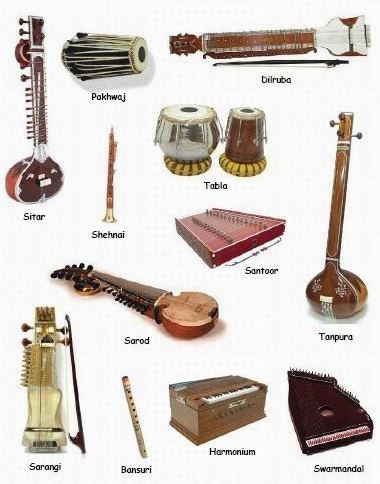
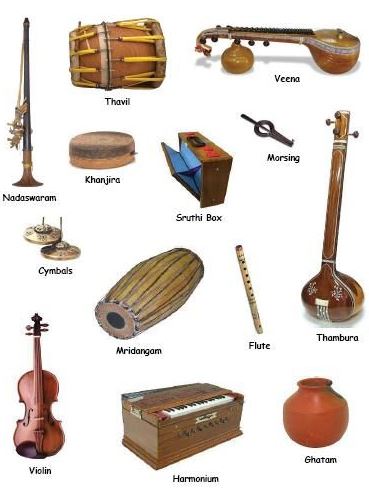

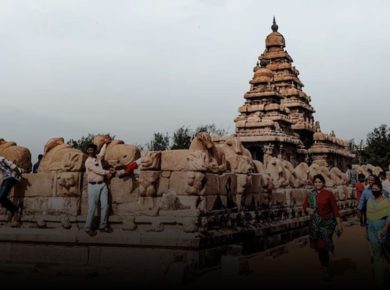
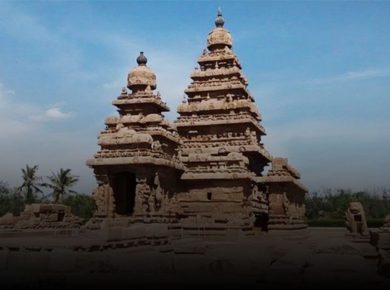

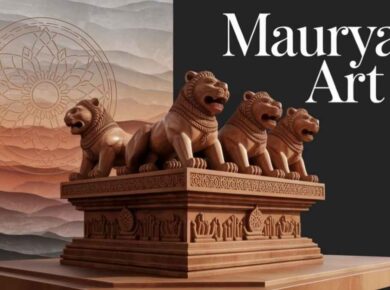
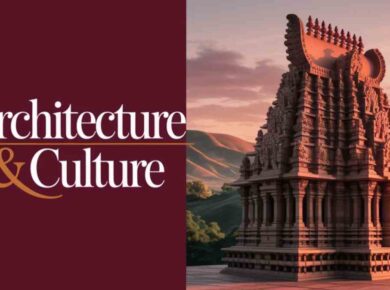
1 comment
nice